Nintendo's Development Secrets, Cloud Gaming & new Killer NIC - GDC '09
by Anand Lal Shimpi & Derek Wilson on March 26, 2009 12:00 AM EST- Posted in
- Trade Shows
This is my first GDC. It’s the Game Developers Conference. I’m not a game developer, but I’m not a regular developer either and I go to the Intel Developers Forum all the time. When Derek went last year he said that there was just too much show, and that next time he’d want me to come to help out. I obliged. Trips out to California always end up being useful in one way or another.
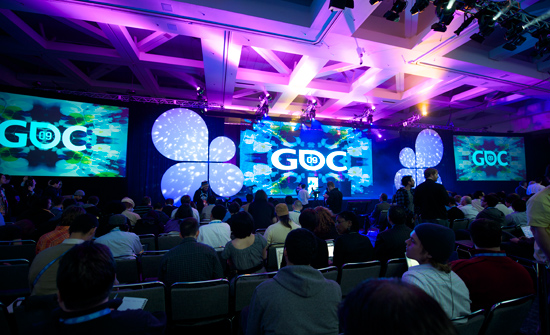
As with all conferences, this one started with a keynote. And not just any keynote. The 2009 Game Developers Conference started with a keynote from the president of Nintendo: Saturo Iwata.
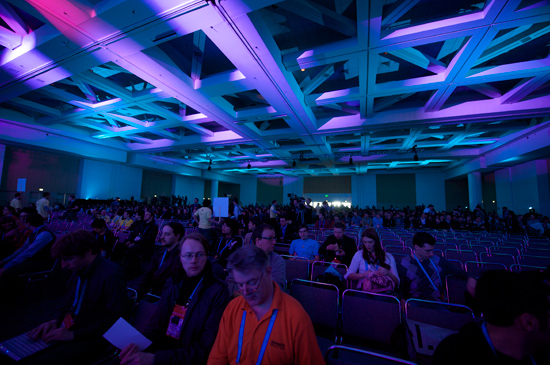
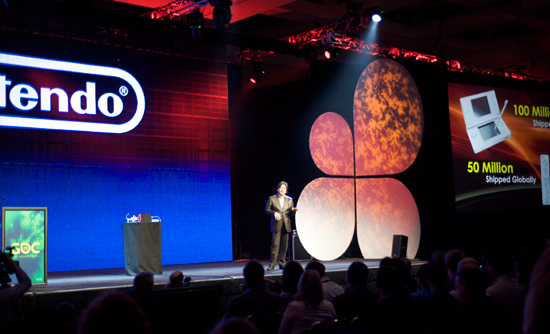
Iwata on stage
I’d never been to a Nintendo keynote before, nor had I ever heard Iwata speak. He spoke with a very mild lisp but was very calm, collected and confident in his delivery. I don’t really know how else to describe it other than that he spoke the way you’d expect the president of Nintendo to speak.
Nintendo has had a huge impact on the video game business in the US and around the world, largely due to the success of the Wii. The Wii is extremely popular, but Iwata really put it in perspective. Nintendo has shipped over 50 million Wii consoles since its launch in 2006. That’s the fastest ramp rate of any console. The Wii Balance Board, the peripheral that comes with Wii Fit, has sold around 15 million units. That in itself is nearly as many units shipped as Sony’s PlayStation 3.

Over 40M consoles shipped by the end of last year. 50 million total since then.
The graph below shows total US video game market growth for an eight year period starting in 2001. The bars represent total video game hardware, software and accessory sales for each year in the US alone.
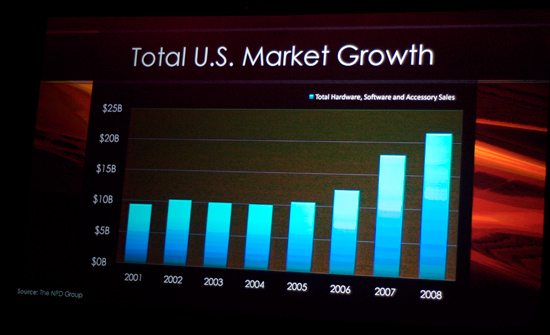
In 2008 the US video game industry broke $20B. That’s pretty impressive. Now look at what percentage of that growth was solely because of Nintendo:
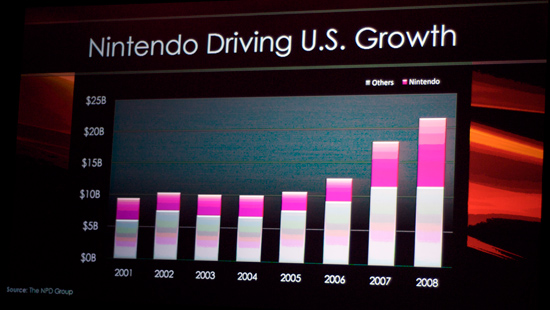
The pink sections of the bars are Nintendo related sales alone
Nintendo accounted for nearly $12B of the $22B US video game industry in 2008. There’s no other way to put it, Nintendo is single handedly driving growth in the US game industry - largely due to the Wii.
The trend is the same in the UK, Germany and France:
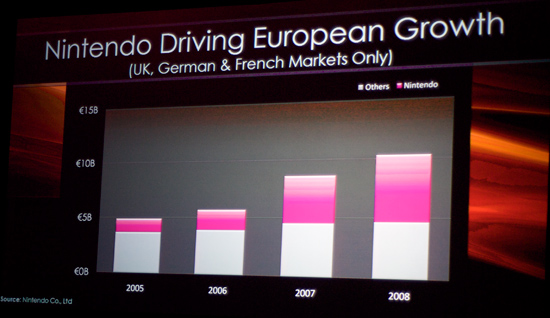
Around half of all video game related sales in those countries last year was because of Nintendo. The numbers are just ridiculous. Cute cuddly video game characters aside, Nintendo is as colossal of a market force as companies like Intel, Microsoft and Google in their respective industries. Nintendo’s size in itself shouldn’t be surprising, but when characterized in terms of the entire video game market it’s shocking.
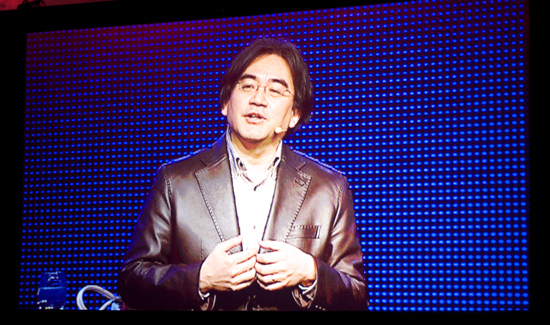
This next part was cool. Iwata took us through how goes about designing games. For those of you who don’t know, Miyamoto is the creator of Mario, Zelda, Pikmin, Nintendogs and some of Nintendo’s other extremely popular franchises. Given that Iwata was speaking to an audience of game developers, choosing to speak about Miyamoto’s approach to game design made a lot of sense. But to me, it was just awesome to hear about how someone who is great at his craft goes about his work. I love stories like that.
Let’s get started.










38 Comments
View All Comments
blagishnessosity - Thursday, March 26, 2009 - link
The way I see it, broadband speeds are decreasing. A decade ago when my family first got road runner, few other families in the neighborhood had it, so there was not nearly the amount of network usage that we see today. Now, everyone has broadband and usage is high, slowing down the network. Now the ISP's are charging more for inferior speeds. In my experience, bandwidth tests back then yielded much higher speeds then they do now. And not just that, I pay more money for less speed (I've always used road runner). So, maybe the technology exists for higher speeds now, but you have to pay a high premium for them. There doesn't appear to be enough competition in the ISP market for this trend to change anytime soon.XiroMisho - Thursday, March 26, 2009 - link
I originally thought this was bloatware... until I tried to do voice chat on a system with a sub par sound card. For the price, and the fact it has voice chat support... then okay, vs buying a better sound card on PCI-E (Which... doesn't exist for under a $150, thank you lethargic sound card community...), this may be worth it... of course going to wait till the price drops to about $79.99.Calin - Thursday, March 26, 2009 - link
This won't help if you're having a sub par sound card. It's like buying larger tires for better grip when you're using a Yugo to tow a large trailer, or somethingBigfootSean - Tuesday, March 31, 2009 - link
Well, sorta. Currently, lots of game voice apps rely on the CPU to do all the encode / decode operations required for gaming voice chat. Sound cards do a good job at DirectSound / EAX sort of stuff, but when it comes to more random stuff like voice, both the apps and the cards develop out of sync.It makes sense for us to do this (and sign up as many partners as possible) because voice chat is a network app that should run on the NIC. Let the CPU worry about the game, let the audio card worry about the explosions and effects, and let the network processor slice, dice, decode, encode and send.
Combined with hardware bandwidth control, this means that your game will never step on your voice chat, and vice versa, assigning clear priorities to each so that neither becomes scrambled.
Thanks for the opportunity to reply!
Lifted - Thursday, March 26, 2009 - link
I still have to play with my friends wii's. :(NewBro - Thursday, March 26, 2009 - link
I'm sorry but am I the only one who thinks the whole OnLive gaming on internet is a terrible idea to start with? First of all the latency issue, and the whole thing running through the internet just doesn't sounds all that great to me. I mean would you want to be interrupted in the middle of a Boss fight in Resident Evil 4 due to a bad connection?xahydra - Sunday, March 29, 2009 - link
Yeah, this whole cloud stuff is getting a little wacky now... Sure there are some really useful services, but it bothers me to see some people get so excited about handing their hardware over little by little and depending on someone else to run their software. I don't want a future filled with dumb terminals that can be managed and controlled more than ever by someone else. The P in PC is for Personal. Its bad enough I have to ask for Microsofts permission to activate my OS when I swap out a peice of hardware. I don't want "subscription software" and "on-demand" gaming... I can pull out my old copy of Freespace 2 and play it at will because it's MINE, I don't have to navigate to the "classics channel" and pay to play over a streamnubie - Friday, March 27, 2009 - link
Personally the ramifications of this are easy to see if you imagine that you could have a server that streams the game to any display you want in or around your house.Instead of having a monster gaming machine tethered to a desk making heat and noise you could have wireless handheld consoles, from the iPhone to the PSP/DS, or even something much slimmer with a 10" screen on a magnesium or aluminum chassis and hours upon hours of battery life. Not to mention streaming to displays all over your house, from the projection room to the kitchen.
What about inviting people over for a "LANparty" without the LAN. Imagine the latency reduction of having everyone on the same system. I can, I already use nVidia dual-view to load up games with split-screen and split-controls onto my PC, and it is a blast (not that these games are common, only a handful of titles at best.)
SLi and Crossfire don't seem particularly interested in allowing users to span 2-8 displays of multi-player goodness from one machine, even though the results are stunning.
The0ne - Thursday, March 26, 2009 - link
I don't think it will work at all when there are tons of users. Sure a few demos and players here seems fine now but just wait til you're at WOW numbers :)Samus - Thursday, March 26, 2009 - link
It makes sense for games like World of Warcraft where latency isn't a big deal...although WoW isn't very graphically intensive to begin with so the service is for the most part unneccessary.FPS's = I agree with you. Latency is ALREADY a problem in deathmatch, and that's measured in milliseconds. I'm sure the video latency will be at least a second.